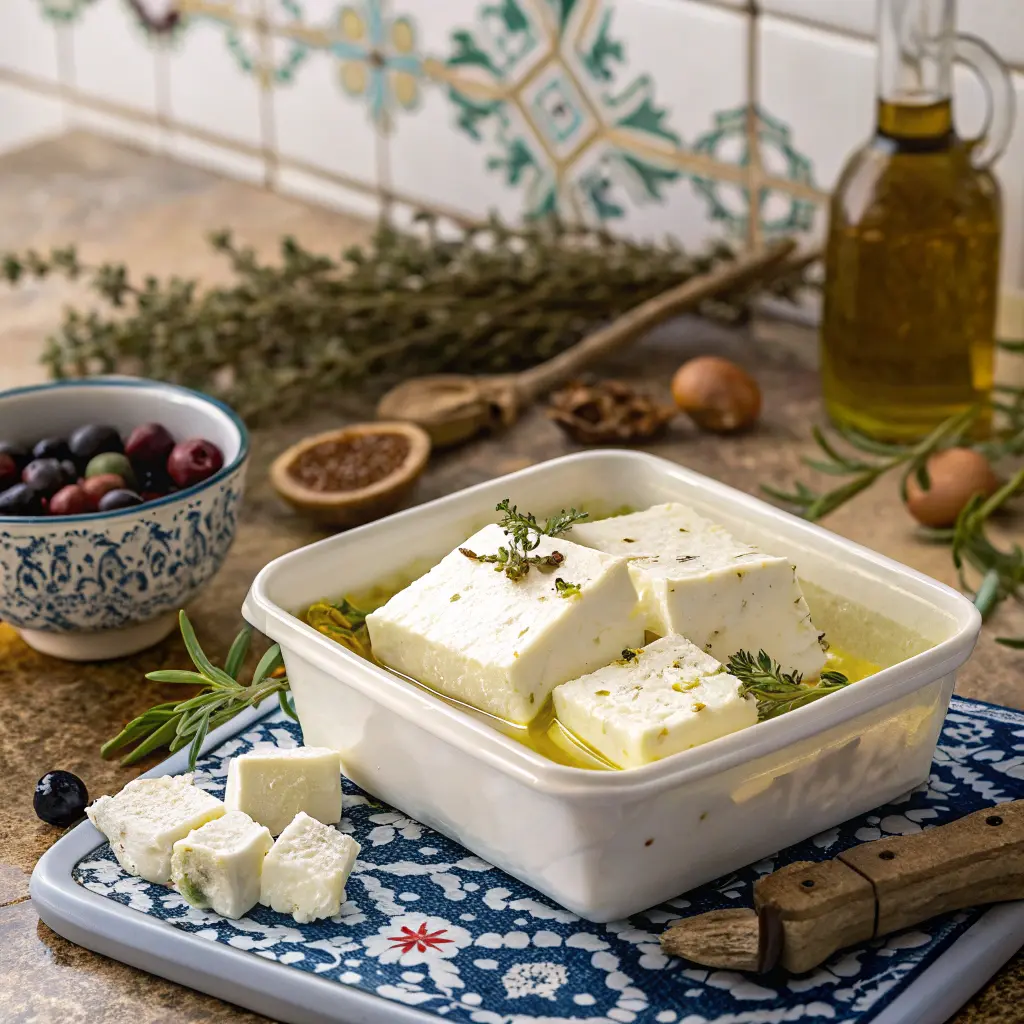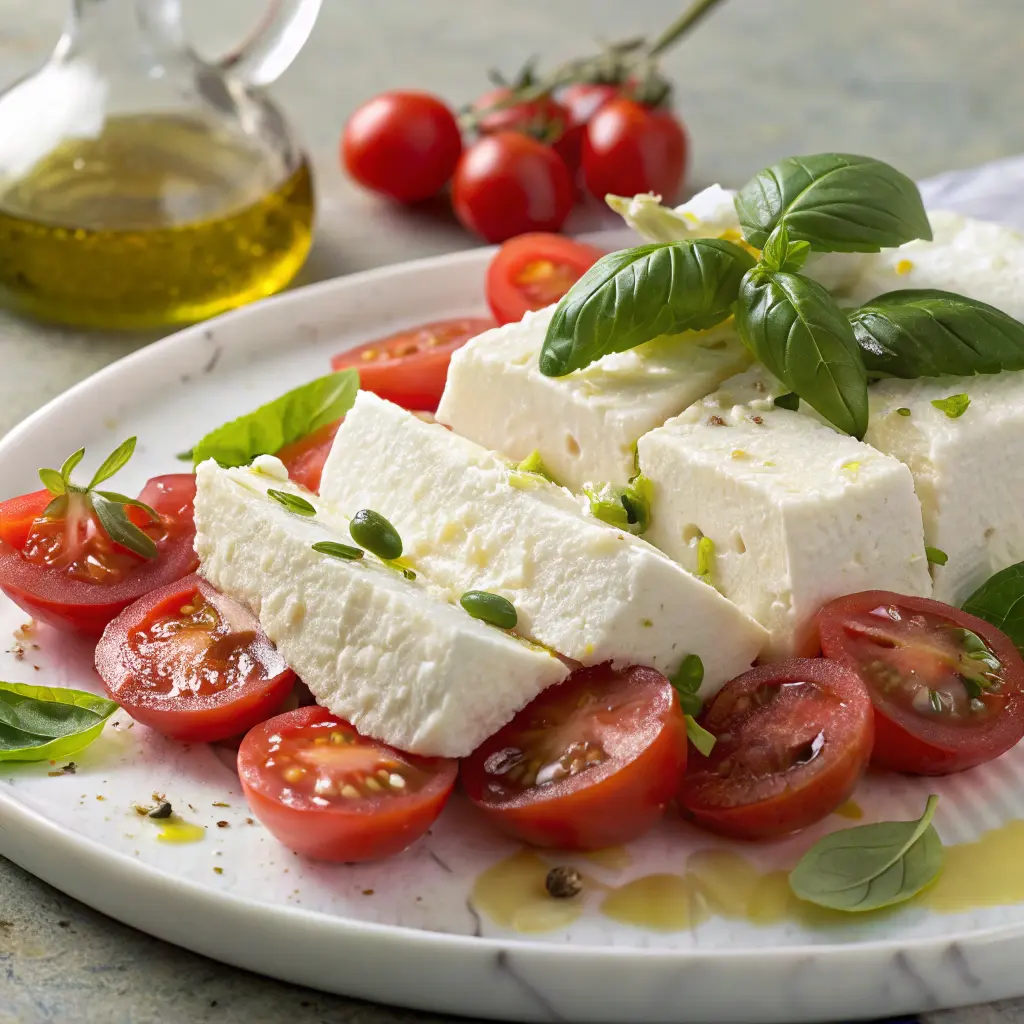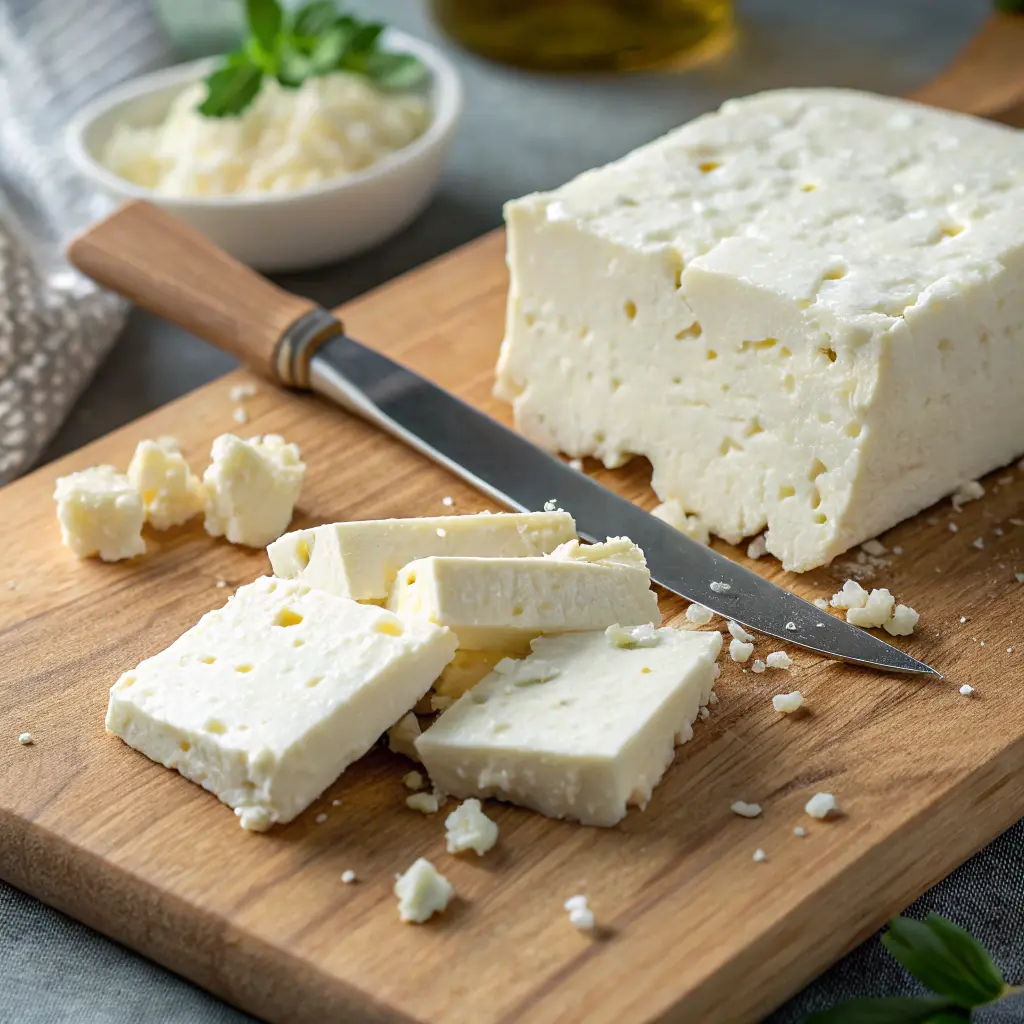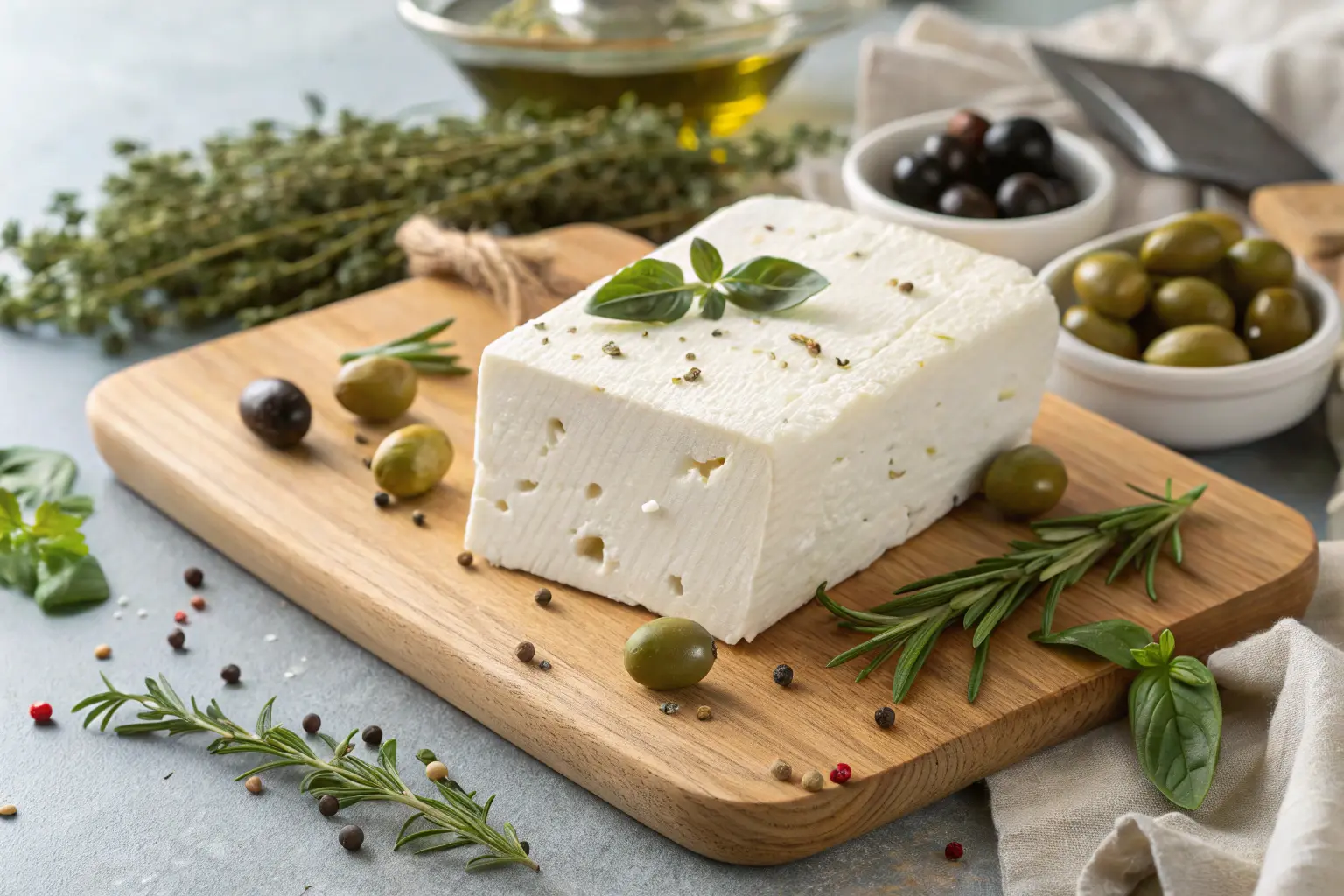Introduction
Feta cheese block is a staple ingredient in Mediterranean cuisine, loved for its tangy taste, crumbly texture, and versatility in both cold and hot dishes. Whether crumbled over a fresh Greek salad, baked into a warm and savory dish, or paired with fruits and nuts, feta cheese block brings a distinctive flavor that enhances various recipes.
But what makes feta cheese block stand out from other cheeses? Is there a difference between authentic Greek feta and other variations? How should it be stored to maintain its freshness? And what are the best ways to incorporate it into your meals?
In this guide, we uncover the secrets behind feta cheese block—from its traditional production methods and nutritional benefits to storage techniques that keep it fresh for longer. Whether you’re a cheese enthusiast or just discovering the wonders of feta, this article will help you understand why feta cheese block is a must-have in every kitchen.
What Makes Feta Cheese Block Unique?

Feta cheese block is not just any ordinary cheese—it holds a special place in culinary history and remains one of the most sought-after cheeses in the world. From its rich cultural heritage to its distinctive taste and texture, feta cheese block stands out for many reasons. Whether you’re looking for a nutritious cheese option, an authentic Mediterranean ingredient, or a versatile addition to your meals, feta cheese block offers an unparalleled experience.
The Origins and Authenticity of Feta Cheese Block
Feta cheese has been a part of Greek cuisine for over 2,000 years, with historical references dating back to Ancient Greece. Today, authentic Greek feta cheese block is PDO-certified (Protected Designation of Origin), meaning that only feta produced in specific Greek regions using traditional methods can be labeled as genuine Greek feta.
The PDO certification ensures that authentic feta cheese block must:
- Be made in Greece—primarily in regions such as Epirus, Thessaly, and Macedonia.
- Contain at least 70% sheep’s milk, with the remainder coming from goat’s milk.
- Be aged in brine for a minimum of two months, which enhances its signature tangy and salty flavor.
This certification sets Greek feta cheese block apart from mass-produced versions, ensuring a high-quality product with a rich and creamy texture.
Ingredients and Nutritional Benefits of Feta Cheese Block
Unlike many commercial cheeses that use cow’s milk, authentic feta cheese block is made from sheep’s milk or a blend of sheep’s and goat’s milk. This unique combination gives feta its characteristic crumbly texture and bold, tangy flavor.
Nutritional Benefits of Feta Cheese Block:
Feta cheese block is more than just a flavorful ingredient—it’s packed with essential nutrients that support overall health:
- High in Calcium: Supports bone health and prevents osteoporosis.
- Rich in Probiotics: Aids digestion and promotes gut health.
- Lower in Fat & Calories: Compared to many aged cheeses, feta cheese block contains less fat and fewer calories.
- High in Protein: Helps with muscle development and satiety.
- Packed with Vitamins: Contains essential vitamins like B12, B6, and riboflavin.
For those looking for a healthy yet flavorful cheese option, feta cheese block is a fantastic choice that can be enjoyed in moderation.
Texture and Taste: Why Feta Cheese Block Stands Out
One of the defining characteristics of feta cheese block is its crumbly yet creamy texture. Unlike crumbled feta, which is often drier and pre-treated with anti-caking agents, a feta cheese block retains its moisture and fresh taste, making it the superior choice for cooking and garnishing.
What Makes the Texture of Feta Cheese Block Unique?
- Firm but crumbly: Perfect for slicing or crumbling over dishes.
- Moist and brined: Enhances flavor and prolongs freshness.
- Creamier when aged longer: Some varieties have a buttery finish when aged beyond the required two months.
The Flavor Profile of Feta Cheese Block
- Tangy & Salty: Due to the brining process, feta cheese block has a bold, sharp taste.
- Slightly Acidic: A pleasant sourness adds to its complexity.
- Earthy & Milky: The sheep’s milk component brings a rich, slightly nutty undertone.
If you’re wondering whether to choose feta cheese block vs crumbled feta, always opt for a block for the best taste and texture!
Popular Brands of Feta Cheese Block
When purchasing feta cheese block, choosing a high-quality, authentic brand ensures you get the best flavor and texture. Below are some of the top-rated feta cheese brands from Greece, France, and beyond.
Greek Feta Brands (PDO-Certified)
- Dodoni – One of Greece’s most popular brands, known for its rich, creamy, and slightly tangy feta cheese block.
- Mt. Vikos – Made from 100% sheep’s milk, this feta has a firm but creamy texture.
- Kolios – An award-winning feta cheese block with a traditional, balanced flavor.
French Feta Brands
- Valbreso – Made from pure sheep’s milk, this French feta is smoother and milder than Greek feta.
- Président – A globally recognized brand offering a creamy and slightly less salty version of feta cheese block.
American & Other International Brands
- Athenos (USA) – A widely available mass-produced feta, great for quick recipes but not as rich as traditional Greek options.
- Shepherd’s Gourmet Dairy (Canada) – A high-quality feta made using Greek techniques, offering a balance between saltiness and creaminess.
Whether you’re looking for Greek feta cheese block with PDO authenticity or a milder version for different recipes, these brands provide excellent options.
How to Store and Preserve Feta Cheese Block

Proper storage of feta cheese block is essential to maintain its texture, flavor, and freshness. Whether you buy an authentic Greek feta block or a locally made alternative, storing it correctly can make all the difference in its taste and shelf life. Below, we cover the best practices for storing feta cheese block, whether or not you can freeze it, and how to avoid common mistakes that lead to spoilage.
Best Practices for Storing Feta Cheese Block
One of the biggest advantages of feta cheese block is its ability to stay fresh for a long time when stored properly. The best way to preserve feta cheese depends on whether it comes in brine or is packaged dry.
- Storing Feta Cheese Block in Brine
- If the feta cheese block comes in a brine solution, always keep it submerged in the liquid.
- If the brine is discarded, prepare a new solution using water and salt to prevent the cheese from drying out.
- Store it in a glass or plastic container with a lid to keep it airtight.
- Storing Feta Cheese Block Without Brine
- Wrap the feta block in parchment or wax paper to allow some airflow and prevent it from becoming too dry.
- Place it inside an airtight container and refrigerate.
- If it becomes too dry, briefly soak it in a mild brine solution before use.
- Using Olive Oil for Storage
- Submerging feta cheese block in olive oil can extend its shelf life and add a rich flavor.
- Add herbs like rosemary, oregano, or garlic to infuse additional taste.
- Keep the container in the refrigerator to prevent spoilage.
Can You Freeze Feta Cheese Block?
Freezing feta cheese block is an option, but it may alter its texture slightly, making it crumblier and slightly drier. If you plan to use feta in cooked dishes, freezing can be a convenient way to store it long-term.
- How to Freeze Feta Cheese Block
- Pat the feta cheese block dry to remove excess moisture.
- Wrap it tightly in plastic wrap or aluminum foil.
- Place it in a freezer-safe bag or airtight container to prevent freezer burn.
- Label the container with the date to track storage time.
- Thawing Feta Cheese Block
- Transfer the frozen feta block to the refrigerator and let it thaw overnight.
- Avoid microwaving or thawing at room temperature, as it can affect the texture.
- If the feta becomes too crumbly after freezing, mix it into baked dishes, salads, or dips rather than serving it fresh.
How Long Does Feta Cheese Block Last?
The shelf life of feta cheese block depends on how it is stored. Proper storage can significantly extend its freshness.
- In brine (refrigerated): Up to 4 weeks
- Without brine (refrigerated): 5 to 7 days
- In olive oil (refrigerated): 2 to 3 weeks
- Frozen (sealed properly): Up to 3 months
Common Mistakes to Avoid When Storing Feta Cheese Block
- Discarding the brine – Many people drain the brine when opening a package of feta cheese, but this liquid helps preserve its moisture and flavor. Always keep the cheese submerged in brine when possible.
- Storing feta uncovered – Exposure to air can dry out the cheese, leading to a crumbly texture and loss of flavor. Use airtight containers or brine for the best results.
- Not checking for spoilage – Feta cheese block that develops a sour smell, slimy texture, or mold (other than its natural white surface) should not be consumed.
- Using excessive salt in homemade brine – While brine preserves feta cheese, too much salt can make it overly salty. A proper ratio is about one teaspoon of salt per one cup of water.
- Storing in metal containers – Avoid using metal containers for feta cheese storage, as they can react with the acidity of the cheese and alter its flavor. Glass or food-grade plastic is the best choice.
Proper storage of feta cheese block ensures that it remains fresh, flavorful, and ready to enhance a variety of dishes. Whether stored in brine, olive oil, or frozen for later use, following these guidelines will help you get the most out of this delicious cheese.
How to Use Feta Cheese Block in Cooking

Feta cheese block is a versatile ingredient that enhances the flavor and texture of many dishes. Unlike pre-crumbled feta, a block retains its natural moisture, making it ideal for a variety of cooking methods, from crumbling over salads to baking in rich, savory dishes. Whether you want to add a tangy kick to fresh ingredients or create a creamy, melty texture in warm meals, feta cheese block is a must-have in the kitchen.
Best Recipes Featuring Feta Cheese Block
Feta cheese block can be used in countless recipes, both traditional and modern. Here are some of the best ways to enjoy its bold, tangy flavor:
- Greek Salad
- One of the most classic uses of feta cheese block, this salad combines cucumbers, tomatoes, olives, and red onions with olive oil and oregano.
- Instead of crumbling the feta, cut it into large slices and place them on top for an authentic Greek-style presentation.
- Baked Feta Pasta
- Made famous by its viral popularity, this dish involves baking a whole feta cheese block with cherry tomatoes, garlic, and olive oil until creamy, then mixing it with pasta for a rich and flavorful meal.
- Spanakopita (Greek Spinach Pie)
- A traditional Greek dish made with layers of phyllo dough filled with feta cheese, spinach, eggs, and herbs.
- The feta cheese block provides the perfect tangy contrast to the spinach.
- Baked Feta with Honey and Nuts
- A simple yet elegant dish where a feta cheese block is drizzled with honey, topped with walnuts or almonds, and baked until warm and soft.
- Feta and Watermelon Salad
- A refreshing combination of sweet watermelon, fresh mint, and cubed feta cheese block, perfect for summer.
- Feta-Stuffed Peppers
- Bell peppers or spicy chili peppers are filled with a mixture of feta cheese, herbs, and olive oil, then roasted for a delicious appetizer.
Feta cheese block adds depth and richness to both cold and warm dishes, making it an ingredient that complements a variety of flavors.
Cooking Tips for Feta Cheese Block
To make the most out of feta cheese block, it’s important to understand the best cooking methods and ingredient pairings.
- Grilling Feta Cheese Block
- Feta has a high melting point, making it suitable for grilling.
- Place it on a sheet of foil, drizzle with olive oil, sprinkle with oregano, and grill for a smoky, enhanced flavor.
- Baking with Feta Cheese Block
- Baking brings out the creamy and slightly caramelized flavors of feta.
- It pairs well with roasted vegetables, tomatoes, and even honey for a mix of savory and sweet.
- Melting Feta Cheese Block
- Unlike cheddar or mozzarella, feta does not fully melt but softens when heated.
- It’s best used in baked dishes or as a topping where its crumbly texture remains intact.
- Pairing Feta with Other Ingredients
- Best Herbs & Spices: Oregano, thyme, rosemary, basil, and black pepper enhance the natural tanginess of feta.
- Best Fruits: Watermelon, figs, apples, and grapes create a sweet contrast.
- Best Proteins: Lamb, chicken, shrimp, and lentils pair well with feta’s salty, creamy texture.
- Avoid Over-Salting Dishes with Feta
- Since feta cheese block is already salty, adjust additional salt in recipes accordingly.
Feta Cheese Block vs. Crumbled Feta: Which Is Better?
Many people wonder whether to buy a feta cheese block or pre-crumbled feta. While both serve a purpose, the block version is often the superior choice.
Feta Cheese Block
✔ Fresher and retains moisture
✔ More versatile for slicing, crumbling, or grilling
✔ Stronger, richer flavor
✔ Free from anti-caking agents and preservatives
Pre-Crumbled Feta
✔ Convenient for quick use
✔ Best for sprinkling on salads or pasta
❌ Often contains additives that affect taste and texture
❌ Dries out faster than block feta
If you want authentic flavor and flexibility in cooking, feta cheese block is the better choice. Pre-crumbled feta is convenient, but its drier texture and added preservatives make it a less desirable option for dishes that require high-quality cheese.
Substitutes for Feta Cheese Block
If you run out of feta cheese block or need a different option for dietary reasons, several substitutes can provide a similar texture and taste.
- Ricotta Salata
- A firmer, aged version of ricotta with a mild saltiness and crumbly texture.
- Works well in salads and pasta dishes.
- Goat Cheese
- Has a creamy, tangy flavor similar to feta but with a softer consistency.
- Ideal for spreads, dips, and cold dishes.
- Cotija Cheese
- A Mexican cheese with a salty, crumbly texture.
- Best used in salads, tacos, and sprinkled over roasted vegetables.
- Halloumi
- Similar to feta but firmer and perfect for grilling.
- Can be a good substitute for feta cheese block in warm dishes.
- Queso Fresco
- A mild, fresh cheese with a crumbly texture.
- Less salty than feta but still pairs well with Mediterranean flavors.
Choosing the right substitute depends on the recipe, but for the closest match, ricotta salata or goat cheese are the best alternatives..
Conclusion
Feta cheese block is more than just a flavorful addition to meals—it is a nutrient-rich, versatile ingredient that enhances a wide range of dishes. Whether used in traditional Greek recipes, baked for a warm and creamy texture, or crumbled over fresh salads, its bold, tangy flavor makes it a favorite in kitchens around the world.
Understanding how to choose high-quality feta cheese block, store it properly, and use it in various cooking methods ensures that you get the best taste and texture every time. Storing feta in brine helps retain its moisture, while freezing it can extend its shelf life for use in cooked dishes. Opting for a block instead of pre-crumbled feta provides superior freshness and flavor.
Whether you are a fan of Mediterranean cuisine or simply looking to explore new flavors, feta cheese block is a must-have ingredient that brings depth and richness to any meal. By using it creatively and pairing it with the right ingredients, you can fully appreciate the unique taste and texture that make feta one of the most beloved cheeses worldwide.

